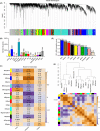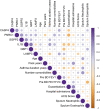Nontypeable Haemophilus influenzae infection of pulmonary macrophages drives neutrophilic inflammation in severe asthma
- PMID: 35570583
- PMCID: PMC9796932
- DOI: 10.1111/all.15375
Nontypeable Haemophilus influenzae infection of pulmonary macrophages drives neutrophilic inflammation in severe asthma
Abstract
Background: Nontypeable Haemophilus influenzae (NTHi) is a respiratory tract pathobiont that chronically colonizes the airways of asthma patients and is associated with severe, neutrophilic disease phenotypes. The mechanism of NTHi airway persistence is not well understood, but accumulating evidence suggests NTHi can persist within host airway immune cells such as macrophages. We hypothesized that NTHi infection of pulmonary macrophages drives neutrophilic inflammation in severe asthma.
Methods: Bronchoalveolar lavage (BAL) samples from 25 severe asthma patients were assessed by fluorescence in situ hybridisation to quantify NTHi presence. Weighted gene correlation network analysis (WGCNA) was performed on RNASeq data from NTHi-infected monocyte-derived macrophages to identify transcriptomic networks associated with NTHi infection.
Results: NTHi was detected in 56% of BAL samples (NTHi+) and was associated with longer asthma duration (34 vs 22.5 years, p = .0436) and higher sputum neutrophil proportion (67% vs 25%, p = .0462). WGCNA identified a transcriptomic network of immune-related macrophage genes significantly associated with NTHi infection, including upregulation of T17 inflammatory mediators and neutrophil chemoattractants IL1B, IL8, IL23 and CCL20 (all p < .05). Macrophage network genes SGPP2 (p = .0221), IL1B (p = .0014) and GBP1 (p = .0477) were more highly expressed in NTHi+ BAL and moderately correlated with asthma duration (IL1B; rho = 0.41, p = .041) and lower prebronchodilator FEV1/FVC% (GBP1; rho = -0.43, p = .046 and IL1B; rho = -0.42, p = .055).
Conclusions: NTHi persistence with pulmonary macrophages may contribute to chronic airway inflammation and T17 responses in severe asthma, which can lead to decreased lung function and reduced steroid responsiveness. Identifying therapeutic strategies to reduce the burden of NTHi in asthma could improve patient outcomes.
Keywords: NTHi; T17 responses; asthma; inflammation; macrophage; neutrophil.
© 2022 The Authors. Allergy published by European Academy of Allergy and Clinical Immunology and John Wiley & Sons Ltd.
Conflict of interest statement
DC reports that he was a postdoctoral researcher on projects funded by Pfizer and GSK between April 2014 and October 2017. RJK received a nonpromotional grant (£35,000) from Novartis to assist in funding initial database support for the WATCH study. PH reports that he is an employee of GSK. TW reports grants and personal fees from AstraZeneca, personal fees and others from MMH, grants and personal fees from GSK, personal fees from BI, and grants and personal fees from Synairgen, outside the submitted work. KS reports grants from AstraZeneca, outside the submitted work. The remaining authors declare that the research was conducted in the absence of any commercial or financial relationships that could be construed as a potential conflict of interest.
Figures





Similar articles
-
Dual RNASeq Reveals NTHi-Macrophage Transcriptomic Changes During Intracellular Persistence.Front Cell Infect Microbiol. 2021 Aug 23;11:723481. doi: 10.3389/fcimb.2021.723481. eCollection 2021. Front Cell Infect Microbiol. 2021. PMID: 34497778 Free PMC article.
-
The role of NTHi colonization and infection in the pathogenesis of neutrophilic asthma.Respir Res. 2020 Jul 3;21(1):170. doi: 10.1186/s12931-020-01438-5. Respir Res. 2020. PMID: 32620122 Free PMC article. Review.
-
Relationships between Mucosal Antibodies, Non-Typeable Haemophilus influenzae (NTHi) Infection and Airway Inflammation in COPD.PLoS One. 2016 Nov 29;11(11):e0167250. doi: 10.1371/journal.pone.0167250. eCollection 2016. PLoS One. 2016. PMID: 27898728 Free PMC article.
-
Combined Haemophilus influenzae respiratory infection and allergic airways disease drives chronic infection and features of neutrophilic asthma.Thorax. 2012 Jul;67(7):588-99. doi: 10.1136/thoraxjnl-2011-200160. Epub 2012 Mar 3. Thorax. 2012. PMID: 22387445
-
Non-typeable Haemophilus influenzae airways infection: the next treatable trait in asthma?Eur Respir Rev. 2022 Sep 20;31(165):220008. doi: 10.1183/16000617.0008-2022. Print 2022 Sep 30. Eur Respir Rev. 2022. PMID: 36130784 Free PMC article. Review.
Cited by
-
Macrophages Orchestrate Airway Inflammation, Remodeling, and Resolution in Asthma.Int J Mol Sci. 2023 Jun 21;24(13):10451. doi: 10.3390/ijms241310451. Int J Mol Sci. 2023. PMID: 37445635 Free PMC article. Review.
-
Species-level, metagenomic and proteomic analysis of microbe-immune interactions in severe asthma.Allergy. 2024 Nov;79(11):2966-2980. doi: 10.1111/all.16269. Epub 2024 Aug 11. Allergy. 2024. PMID: 39127908 Free PMC article.
-
Sputum microbiota and inflammatory subtypes in asthma, COPD, and its overlap.J Allergy Clin Immunol Glob. 2023 Nov 21;3(1):100194. doi: 10.1016/j.jacig.2023.100194. eCollection 2024 Feb. J Allergy Clin Immunol Glob. 2023. PMID: 38155860 Free PMC article.
-
In vivo gene expression profile of Haemophilus influenzae during human pneumonia.Microbiol Spectr. 2023 Sep 14;11(5):e0163923. doi: 10.1128/spectrum.01639-23. Online ahead of print. Microbiol Spectr. 2023. PMID: 37707456 Free PMC article.
-
Catalase-encapsulated matrix metalloproteinase-9 responsive nanogels for modulation of inflammatory response and treatment of neutrophilic asthma.J Nanobiotechnology. 2025 May 24;23(1):374. doi: 10.1186/s12951-025-03470-3. J Nanobiotechnology. 2025. PMID: 40410884 Free PMC article.
References
-
- Lambrecht BN, Hammad H. The immunology of asthma. Nat Immunol. 2015;16:45‐56. - PubMed
-
- Ishmael FT. The inflammatory response in the pathogenesis of asthma. J Am Osteopath Assoc. 2011;111:S11‐S17. - PubMed
-
- Deckers J, Branco Madeira F, Hammad H. Innate immune cells in asthma. Trends Immunol. 2013;34:540‐547. - PubMed
Publication types
MeSH terms
Substances
Grants and funding
LinkOut - more resources
Full Text Sources
Medical
Molecular Biology Databases

